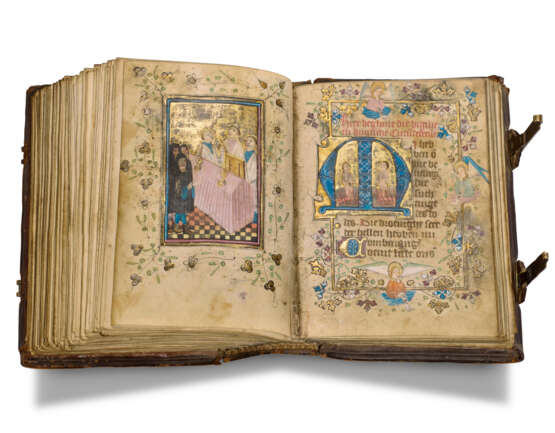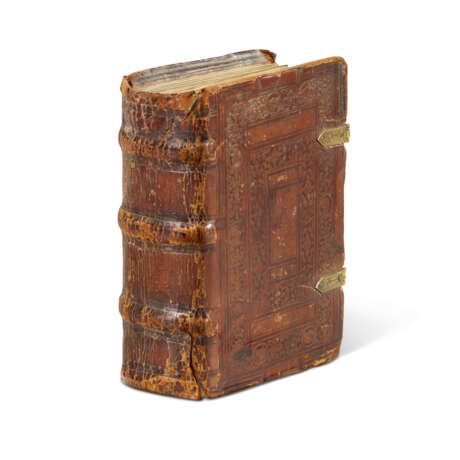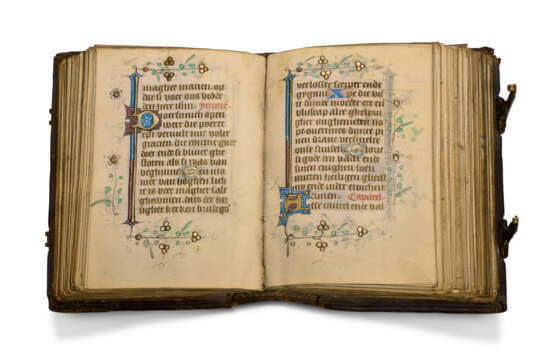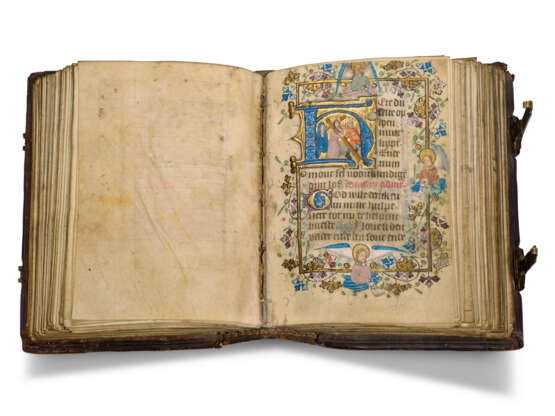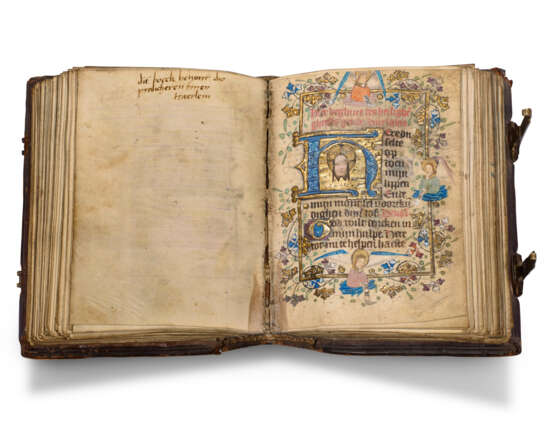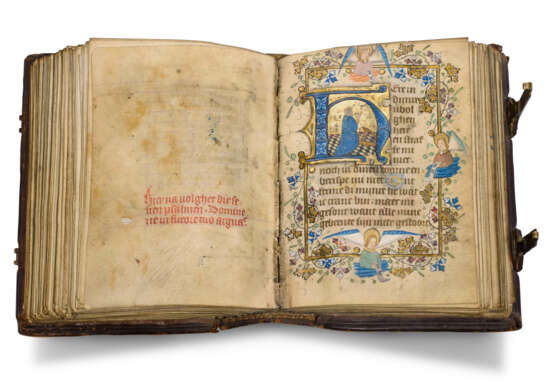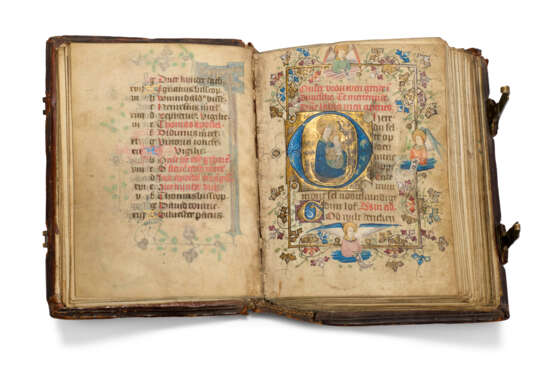ID 1249896
Lot 25 | Followers of the Masters of Zweder van Culemborg
Valeur estimée
£ 15 000 – 20 000
Book of Hours, use of Utrecht, in Dutch, illuminated manuscript on vellum [Utrecht, c.1420s]
A delightful pocket-sized prayerbook with a beautiful program of illumination incorporating a lavish use of burnished gold.
130 x 95mm. ii (paper) + 225 leaves + iii (paper), collation: 1-26, 3-188, 194, 20-238, 249 (i an inserted singleton), 25-298, guard strips from a 13th-century manuscript visible at first and final gatherings, modern pencilled foliation, 14 lines, ruled space: 72 x 47mm, rubrics in red, one-line initials alternately of burnished gold or blue with penwork decoration, two- to four-line initials in burnished gold on blue and red grounds with white decoration, with similar bar borders and three-quarter borders of sprays of leaves, daisies and trefoils in burnished gold and green, five large historiated initials on burnished gold grounds with full-page borders inhabited by half-length angels holding scrolls, one full-page miniature with full border (likely lacking four inserted singletons with miniatures, close cropping touching upper margins of full-page borders, signs of use and wear including browning, smudging and cockling). 16th-century Netherlandish binding of blind-stamped calf over wooden boards, panels with portrait medallions, vases and scrolling foliate decoration, metal clasps and catches (extremities slightly worn, short split to head and foot of spine). Modern slipcase.
Provenance:
(1) The liturgical use is for the diocese of Utrecht, covering the northern Netherlands; the calendar points to the east of the diocese, including saints in red for the Utrecht feasts of Sts Pontian (January 14), Servatius (May 13), Boniface (June 5), Odulf (June 12), Lebuin of Deventer (translation November 12), Lambert (September 18), Willibrord (November 7), and the patrons of Cologne, Gereon and Victor (October 10). The border illumination is typical of manuscripts produced in Utrecht and distinctive penwork motifs share characteristics of the bone stijl named in A. Korteweg, Kriezels, aubergines en takkenbossen, 1992, pp.36-41.
(2) Contemporary ownership inscription on final leaf, partially erased, `[Dit boek] hoert Ioncfruen […]’.
(3) Dominican convent, Haarlem, inscribed c.1500 on f.116v, ‘dit boech behort die predicheren hinen Haerlem’.
(4) Henry Bemrose, Derby, his signature on front endleaf.
(5) Laurence W. Hodson (1864-1933), book label inside upper cover; bought from Bernard Halliday.
(6) Sotheby’s, 20 June 1995, lot 81.
Content:
In the Dutch translation of Geert Grote, a few rubrics in Latin: Calendar ff.1-12v; Office of the Virgin, use of Utrecht ff.13-91: matins, f.13, lauds f.29v, prime f.46, terce f.53, sext f.58v, none f.64v, vespers f.71, compline f.82; short prayers, including to St Thomas Aquinas on the Holy Sacrament ff.91-99; ruled blank f.100; Hours of the Cross ff.101-115; ruled blank f.116; Hours of the Holy Spirit ff.117-143v; rubric f.144v; Penitential Psalms and Litany ff.145-176v; Office of the Dead ff.178-225.
Illumination:
The engaging illumination is in the early style of the Masters of Zweder van Culemborg, named after a Missal made around 1425 for Zweder van Culemborg, one of the contenders for the bishopric of Utrecht (Bressanone, Biblioteca del Seminario Maggiore, Ms C 20, see E. Scheiber, Niederländische Buchmalerei, die Miniaturen des Culenborch-Missales in Brixen, 1992); the name encompasses a group of illuminators working together in a common style, which dominated Dutch manuscript illumination in the 1420s and 1430s (see H. Defoer et al. eds, The Golden Age of Dutch Manuscript Illumination, 1990, pp.98-116). Initials are on burnished gold grounds, in two instances combined with black-and-white chequered floors, figures have soft, delicate faces and a characteristic bright palette of orange, pale pink and greens is used in the careful modelling of drapery. The half-length angels emerging from clouds which inhabit the borders are a familiar, appealing feature of the Masters’ manuscripts. A distinctive daisy motif combined with green leaves in the text borders also features in the Hoya Missal, Münster, Universitätbibliotek, Ms.41, dated c.1420, and a Book of Hours of the same date in the Art Institute of Chicago (no.1923.290). The style of the full borders, with a mixture of painted and gilded leaves on scrolling tendrils and thin burnished gold bars, compare with a Book of Hours dated c.1420 now in The Hague, Koninklijke Bibliotheek (Ms 133 M 131) and the earlier section of an Hours of c.1435, Walters Art Gallery, Ms. W.168 (see The Golden Age, Cat. Nos. 29 and 37 respectively).
The subjects of the historiated initials are: the half-length Virgin with Child in the crescent moon f.13; Christ carrying the Cross f.101; Holy Face of Christ f.117; David praying f.145; two souls kneeling in Purgatory, f.178. The miniature on f.177v shows a Funeral Service.
| Lieu d'origine: | Europe de l'Ouest, Europe, Les Pays-Bas |
|---|---|
| Catégorie maison de vente aux enchères: | Manuscrits médiévaux et de la Renaissance, Livres et manuscrits |
| Lieu d'origine: | Europe de l'Ouest, Europe, Les Pays-Bas |
|---|---|
| Catégorie maison de vente aux enchères: | Manuscrits médiévaux et de la Renaissance, Livres et manuscrits |
| Adresse de l'enchère |
CHRISTIE'S 8 King Street, St. James's SW1Y 6QT London Royaume-Uni | |
|---|---|---|
| Aperçu |
| |
| Téléphone | +44 (0)20 7839 9060 | |
| Commission | see on Website | |
| Conditions d'utilisation | Conditions d'utilisation |
